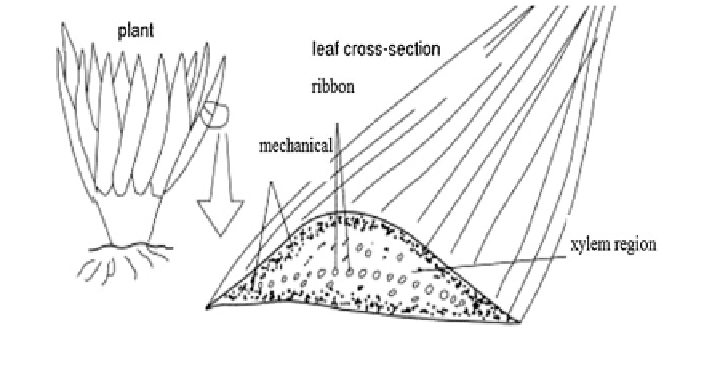Civil Engineering Reference
In-Depth Information
Fig. 4 An illustration of the cross section of a sisal leaf; adapted from (Li et al.
2000a
) with kind
permission of Elsevier, 2013
contain several different types of fibres. Sisal, for example, contains three types of
fibres: mechanical, ribbon and xylem, see Fig.
4
the cross section of a sisal leaf.
Like building insulation materials, vegetable fibres can also be categorized in
many different ways. A more detailed version of their classification has been
provided by Suddell which classified them as (Suddell
2008
): (1) straw (e.g. corn
and wheat); (2) grass (e.g. bamboo); (3) bast (e.g. flax and hemp); (4) leaf (e.g.
sisal); (5) seed (e.g. cotton); (6) fruit (e.g. coconut and pineapple); and (7) wood
(e.g. pinewood and sawdust, depending on their original sources).
As described in (Suddell
2008
), vegetable fibres are rich in different types and
functions determined by their various and complex structures. All plant and
vegetable cells have cell walls which provide support and strength for them. Cell
walls are important features for their cells that perform specific and essential
functions. As the plant or vegetable matures, the cell walls thicken and give more
strength and stiffness. There are two main classes of cells: single-celled vegetable
fibres, cotton for instance, are called ultimates. They have unicellular structure.
Most vegetable fibres are multicellular-structured with a bundle of single cells of
varying lengths and widths. The cell walls are complex composites which have
hierarchical internal structures consisting of cellulose fibrils embedded in lignin
hemicellulose matrix.
The major component in the cell walls of vegetable fibres is cellulose which is a
long chain of linked sugar molecules that gives fibres or their cell walls the
strength. The chains are held together by amorphous hemicellulose and lignin and
form microfibrils. The microfibrils are submicroscopic structures that are grouped
to form the fibrils which in turn are grouped to form the fibres, see Fig.
5
of a
schematic structure of a fibre adapted from (Dufresne
2008
; Rong et al.
2001
;
Pietak et al.
2007
).
From Fig.
5
, we can see that fibres exhibit a multiscale structural hierarchy.
This
structural
hierarchy
can
play
a
major
part
in
determining
the
fibres'

